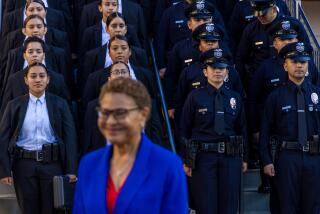Academy for 2 : Pair Make Up Smallest Class in County Fire Department History
As far as Melvina Lay and Robert Blackwell are concerned, three’s a crowd.
The two are trainees of Ventura County Fire Department’s 33rd Fire Academy--the only two.
Lay, 32, of North Hollywood and Blackwell, 23, of Thousand Oaks make up the smallest academy in the department’s history. But they say they like it that way, because they’re getting more attention and training than if they had more classmates.
Because of county budget cuts, the Fire Department decided to fill its only two openings with Lay and Blackwell, who had dropped out of the previous academy because of health reasons, said Battalion Chief Michael P. Estrada, 36, a 17-year Fire Department veteran.
During the special 14-week course that ends Aug. 30, the two will lug water hoses, fight oil and brush fires, hoist ladders and drive fire engines.
Fighting house fires might be a bit more difficult for the two to learn because of a lack of sites, Estrada said.
“It’s very difficult to burn somebody’s house down for a training prop,” he quipped as his students began a water-hose exercise Thursday on the grounds of Camarillo State Hospital. Both Lay and Blackwell were hired by the Fire Department when they enrolled in the 18-member 32nd Fire Academy class. The class graduated May 23, but Lay and Blackwell were forced to drop out after only five weeks of training.
Blackwell, whose father is a Los Angeles firefighter, suffered a fractured ankle and was placed on light-duty industrial leave.
But he never lost his desire to become a firefighter.
“I grew up in a fire department family,” Blackwell said. “I saw the good life, and it’s an exciting job.”
Lay, a Nebraska native and track competitor who hopes to compete in the 1992 Summer Olympics in Barcelona, Spain, said she dropped out of the previous academy because she was not prepared for the heavy lifting and hoisting required of trainees.
But her desire for the intense physical activity required of academy rookies lured her back into the program.
“I was training for the Olympics and I saw this guy pulling this (rope) and thought that’d work on my upper body,” said Lay, who was on a leave of absence from the Fire Department before returning to the academy.
The starting pay of about $30,000 a year and time off each month helped her decide on a career battling blazes.
“We only work 10 days a month” in 20-hour increments, she said while perched on the ledge of a yellow Fire Department firetruck.
Although the class is smaller, the skills learned are the same as those taught in usual classes, said Capt. George Hatt, a 19-year Fire Department veteran who has planned the training program for seven years.
The two are learning to drive fire engines, handle fire hoses, hoist 35-foot ladders, administer emergency medical assistance, fight brush and oil fires, operate rescue equipment, investigate suspected arson and assemble and use breathing apparatus.
Since most academy classes consist of 12 to 28 trainees organized into teams of four or five firefighters, Hatt said he helps out with exercises that call for at least three people.
“The trainees are learning very well,” Hatt said. “We’re into the third day of hose training, they’re driving the engine well. . . . I expect by the end of three weeks they’re going to be pros.”
Hatt said Lay and Blackwell are fortunate because they are getting training that most rookies in a larger academy don’t get.
For example, in a full-sized class, the department hires an engineer to monitor water pressure from fire hydrants during hose exercises.
“Normally . . . all (the trainees) do is pull the hose,” Hatt said. “Because this academy is so small, we decided we’re going to operate like an engine company and that would be a part of our training.”
Although the two are not being evaluated on pumping and driving a fire truck, the advanced training will place them ahead of other rookies when promotion time comes around, Hatt said.
“It’s good experience. . . . I’m very pleased with what I’ve seen so far.”
Both Lay and Blackwell said the intense training in the last academy put a damper on their personal lives, but this time they are better prepared to deal with any obstacles.
Lay, who has nine sisters, is the legal guardian of her three nephews: Billy, 2 1/2; Leroy, 7, and Chay, 16. She prepares school clothing and lunches the night before so she can be up by about 6 a.m. to prepare for the academy. Fortunately, she said, her sisters help her with the children.
“There are times when we’re here and you’re just too tired to go home and cook dinner and help with homework, so they’ll take (the children) for a week at a time.”
Blackwell, who has a 10-month-old son, Derek, agreed that the stress of the academy can interfere with a trainee’s personal life. “When I started the first academy, my fiancee left me,” he said. “Now we’re trying to put things back together.”
Lay said she was also engaged to be married when she began training in the first academy. “He just totally tripped when he found out I was the only female in the class, so I had to trade him in for something I can depend on. . . . I traded him in for a car,” she said, laughing.
More to Read
Sign up for Essential California
The most important California stories and recommendations in your inbox every morning.
You may occasionally receive promotional content from the Los Angeles Times.










